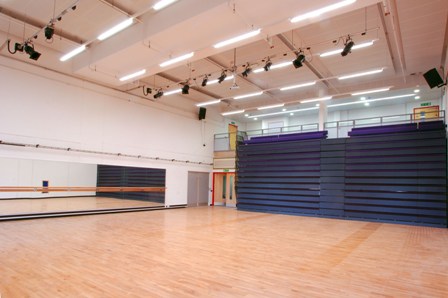Liz Delany: building partnerships for sport and schools

Above and below, Bristol Brunel, a Building Schools for the Future projects

A sporting chance for education
Building Schools for the Future is a multi-billion pound project that is aimed at transforming the education environment. The Leisure Review spoke to Liz Delany about why the world of sport should be sitting up, taking notice and getting ready to get involved
Liz Delany: building partnerships for sport and schools

Above and below, Bristol Brunel, a Building Schools for the Future projects

The world of education is a complex environment and, even though the links between leisure and education are long established and partnerships between the two sectors are growing ever stronger, it can still seem arcane and challenging to outsiders. Liz Delany, PE and Sports Adviser with Partnerships for Schools, will concede the point but she is equally sure that leisure professionals taking an interest in education would find their efforts worthwhile. Liz has good reason for her confidence; more accurately, she has around two and half billion reasons for confidence, all of them pounds sterling.
“Building Schools for the Future is the largest single capital investment programme in years,” Liz said. “It’s aim is to rebuild and renew virtually all of England’s secondary schools. That’s about 3,500 schools. At it’s core the programme is about the transformation of education and learning, creating world-class learning environments and providing the buildings to support that aim. So although it’s called Building Schools for the Future, the programme is not primarily focused on buildings.”
The Building Schools for the Future programme is, in the language of the Department for Children, Schools and Families, about “transforming learning and teaching environments”. Its aim is to bring all of England’s secondary schools to “twenty-first century standards”, delivering a strategic capital investment programme over fifteen years with a proposed budget that equates to an annual spend of between £2.5bn and £3bn a year. Working through Partnerships for Schools, the national delivery vehicle for Building Schools for the Future, the programme makes allocations to local authorities, in waves, the first six of which have been made based on the indices of deprivation, but consultation with local authorities is being undertaken to decide on how the remaining authorities’ areas will enter the programme. Funding is expected to be directed at 50% new build, 35% for “major refurbishment” and 15% for “minor works”; information and computer technology will be 10% of the budget.
These are big numbers in anyone’s budget and, with partnership working drummed into PE and sport managers at every turn, the opportunities would seem to be obvious. However, it seems that things have got off to something of slow start.
“The PE and sport function was recognised early on but there wasn’t any dedicated human resource working on it,” Liz explained. “In the first two to three years, while it was recognised that this was an important area, it perhaps wasn’t getting the profile it should have done. Sport England, the Youth Sport Trust and Partnerships for Schools got together to fund a dedicated resource. Out of that three posts were advertised last summer and I took up my post last November; my colleague Mark Perkins in February.”
Liz spent the first few months in post developing a working protocol between the three organisations and establishing a framework designed to engage the PE and sport sector in the Building Schools for the Future programme. The framework envisages a local core sports stakeholder group comprising representatives of the county sports partnership, a local authority leisure lead, a head teacher from a specialist sports college and a key PE strategic adviser for the authority. This group then inputs to the Building Schools for the Future programme.
This focused and somewhat prescriptive approach is necessitated by the programme’s time scales on the programme, which are very tight, and a timetable for the decision-making process which rolls on relentlessly. Each of the key representatives has a role to play in engaging their own networks and developing a co-ordinated approach and vision If PE and sport is to have any influence on how the funding is allocated it has to make sure that it is ready to make its case for investment at the appropriate moment. As Liz explained, this moment is likely to be sooner rather than later.
“The programme runs to a very tight timetable and has several key stages within it. The first one is a remit or ‘kick off’ meeting – appropriately named – and it is just eight weeks later that the authority produces its first vision document, called ‘A Strategy for Change’. This says what they are going to do and we as a sector – the PE and sports sector – need to have already done a lot of preliminary work so that we can say, for example, how PE and sport has been shown to impact on attendance and attainment; therefore we know we can help deliver, we would like to do more of this but to be able to do that we need x or y facilities. And we need to be in a position to articulate this before that kick off meeting.”
The key message for the PE and sport sector from Partnerships for Schools is that there is a resource available and a process that needs to be engaged. Liz is at pains to point out that it is a massive opportunity.
“Since we’ve been appointed we’re playing catch up. We’re being proactive with wave five, saying, come on PE and sport, this is your real opportunity so get ready and input to this. Obviously in the future we are hoping to start work with authorities more than a year ahead to get the sector engaged. There’s a time line for authorities to follow within the Building Schools for the Future programme and our role is to highlight that this time line isn’t going to stop for anyone; we need to seize the opportunity. The PE and sport sector now has an accepted framework to work through but the ownership is with those key representatives to take this forward. The group needs to take responsibility to make sure that it has what is required at those key stages because no one is going to wait.”
There are clearly significant challenges for local authorities looking to engage the Building Schools for the Future programme, not least the need to engage early, the time scales involved, the gathering of stakeholder inputs, plus the visioning required to join up agendas and funding across sectors. However, the Partnerships for Schools team has also noticed that getting elements of the PE and sport sector to think beyond conventional facilities is another challenge to add to the list.
“Some people have only thought buildings and haven’t latched onto the power of sport argument,” Liz said. “For every key agenda within the authority you can make an argument that sport and PE can deliver and evidence that case. You can then make the case for facilities to increase this work and in doing so insure that PE and sport is at the heart of the developments.”
Possibilities and transformation should be the key themes of the PE and sport approach, according to Liz. While some local authorities have embraced the possibilities, others have yet to grasp what could be included.
“For me the key message is that for the PE and sport sector this is a huge opportunity,” Liz said. “We must work through the stakeholder group because it’s a big complex project and project directors need one key contact but if we work together who knows what we can achieve.”
© Copyright of all material on this site is retained by The Leisure Review or the individual contributors where stated. Contact The Leisure Review for details.